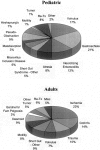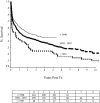2003 report of the intestine transplant registry: a new era has dawned
- PMID: 15798462
- PMCID: PMC1357064
- DOI: 10.1097/01.sla.0000157265.85388.a1
2003 report of the intestine transplant registry: a new era has dawned
Abstract
Summary background data: The intestine has been more difficult to transplant than other solid organs. We analyzed registry data to determine the scope and success of intestine transplantation in the current era.
Methods: All known intestinal-transplant programs participated. Patient- and graft-survival estimates were obtained using the Kaplan-Meier product limit method and were analyzed with the Wilcoxon statistic.
Results: Sixty-one programs provided data on 989 grafts in 923 patients. Four patients were lost to follow-up. The short-gut syndrome was the most common primary indication for transplantation. Sixty-one percent of the recipients were < or =18 years. Proportionally more combined intestinal and liver transplants were performed in this group. More than 80% of all current survivors had stopped parenteral nutrition and resumed normal daily activities. A multivariate analysis of cases within the last 5 years revealed that transplantation of patients waiting at home, recipient age, antibody induction immune suppression, and center experience with at least 10 cases were associated with improved patient survival. One-year graft survival rates of 81% were achieved in patients who were induced with antithymocyte globulin and maintained on tacrolimus.
Conclusions: Transplantation is an effective therapy for the treatment of patients with end-stage intestine failure who cannot tolerate parenteral nutrition. With newer immune suppressive protocols, 1-year graft and patient survival rates approach the results of liver transplantation. Further improvement in survival are expected with early referral since suitable donor organs are scarce and survival rates are better when patients are well enough to wait at home for their transplant.
Figures





Comment in
-
How successful is intestinal transplantation and what improves graft survival?Nat Clin Pract Gastroenterol Hepatol. 2005 Jul;2(7):306-7. doi: 10.1038/ncpgasthep0218. Nat Clin Pract Gastroenterol Hepatol. 2005. PMID: 16265283 No abstract available.
References
-
- Newell KA. Transplantation of the intestine: is it truly different? Am J Transplant. 2003;3:1–2. - PubMed
-
- Kirkman RL. Small bowel transplantation. Transplantation. 1984;37:429–433. - PubMed
-
- Grant D. Current results of intestinal transplantation: the International Intestinal Transplant Registry. Lancet. 1996;347:1801–1803. - PubMed
-
- Grant D. Intestinal transplantation: 1997 report of the international registry: Intestinal Transplant Registry. Transplantation. 1999;67:1061–1064. - PubMed
Publication types
MeSH terms
Grants and funding
LinkOut - more resources
Full Text Sources

